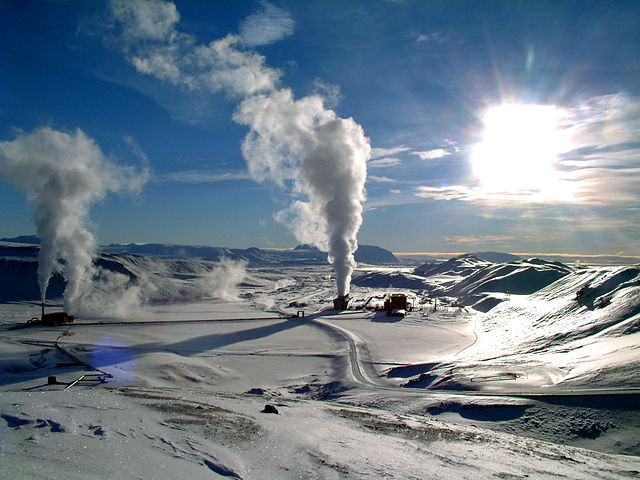

As we search for alternatives to fossil fuels, and countries try to become self sufficient with energy, interesting science happens. In Iceland they have found a way to tap heat almost directly from Magma, potentially improving the efficiency of geothermal power… tenfold!
Iceland has long had a unique position and proactive approach to the energy problem. As one of the most volcanically active nations on the planet, they are now harnessing the heat beneath their feet to provide for over half their energy needs. That includes close to 30% of their electricity (the rest is from hydroelectric sources). Born of necessity, when the country was impoverished in part due to crippling energy imports, they managed to become completely self sustained with regards to static energy. Even better, they are now seriously working on exporting it to countries that need it to meet their renewable energy quotas. Papers stating that intent have been signed with the UK.
Geothermal, How and What
Geothermal power is not new, not at all actually. The ancient Romans left written details of how they used hot springs to heat their houses and baths. But let’s face it, we’re human, our Neolithic ancestors must have appreciated a good, hot, relaxing soak, same as us. The only difference between them and us is that we have the technology to drill really deep and create hot springs where we want them.

Image source: User:Yosemite / Wikimedia Commons / CC-BY-SA 3.0
In principle, it is possible to drill for water hot enough to be useful in deeper layers of the Earth’s crust anywhere. The temperature of the rock goes up by about 25°C for every kilometer (75°F every mile) you go down. In practice, the best places are near fault lines, between the tectonic plates, or near hot spots, such as Hawaii or Yellowstone. Geothermal energy is used in the UK but the water they bring up is only between 60 and 80°C (140 and 176°F), good enough for heating buildings but not for generating electricity. For that you want steam, the hotter the better.
Drilling deeper is more expensive, as much as half the initial investment is already needed for a usual plant. So, for hotter water you need to find shallower heat to keep it all financially healthy. Yet, in Iceland they went looking for more heat, deeper down, anyway.
The Icelandic Incident
The Iceland Deep Drilling Project (IDDP), a collaboration between 3 Icelandic energy companies, set out to find some proper heat. The idea was to drill down to layers that are between 450 and 600°C (840 to 1110°F) in order to produce enough steam to generate between 40 and 50 MW of electricity; ten times what a typical geothermal power plant would produce. However, to do this they estimated they had to drill down to between 3.5 and 5 km (between 2.2 and 3.1 mi). In 2009 they went for it and drilled the IDDP-1 well near the Krafla power plant.

Image source: Author: Ásgeir Eggertsson / Wikimedia Commons
It all went smoothly until they got to 2100 meters (6900 feet) deep. The drill hit a magma intrusion, a blob of molten rock left over from an eruption in the past, between 900 and 1000°C (1650 and 1830°F). This meant, in general, that the drilling had failed. However, in Iceland, they decided to pull it out of the fire, accepted they could get their fingers burnt and do science! How about them Vikings!
They figured that if it’s hot, it should work. So, instead of plugging the bottom of the well with concrete, they lined it with steel and managed to control the magma. Then they pumped cold water down, right next to the magma, causing the rock to fracture and allowing ground water through. This is the procedure known as fracking. In the oil industry it is done too but over much larger areas and with the use of some pretty nasty chemicals. In this case only water is used and just the surroundings of the borehole are fractured. Finally the hot, high pressure ground water was released up through those fractures into the well and, at the surface, turned into superheated steam of 450°C (840°F) for months on end, a world record.
The measurements showed that the steam produced would have been capable of supplying 36 MW of electricity. Seven times as much as a conventional geothermal well would provide. More than half of what the nearby, 60 MW Krafla plant produces. The daring experiment, with inevitable problems, has paid out in invaluable information. The next time a drilling operation hits magma it will be like striking oil. Granted that 36 MW is far short of the 660MW an average coal powered plant can supply but it is a matter of scaling up. The current Krafla power plant is fed steam from 18 wells. If those wells were 36 MW each it would supply pretty much the same power as a coal burning plant.
Upsides and Downsides
The knowledge gained has opened the door to much better geothermal power production in a way that was previously not really considered. Drilling down to shallow magma intrusions will cut costs as compared to drilling down the full 5 km. It is very low emission energy; hot, high pressure water is simply released and fed into steam turbines. No fuel needs to be shipped in.
There are however a few considerations:
It is not quite zero emission. Dissolved CO2 and methane for instance, will be released with the steam. Yet, we should bear in mind that these come nowhere near fossil fuel emissions. It is likely possible to scrub the steam before release and remove most of the offending chemicals it might contain.
It uses existing ground water. The water that comes up from down below is, in essence, rainwater. It percolated down over centuries to reach those depths. If we were to pump it up faster than it is replenished the party could be over too soon. That might even be the least of it, in the long run, as it might affect the shallower groundwater levels and all that is tied in to that. If need be, it is quite feasible to pump water, or even the condensed steam, back down but that will impact overall efficiency.
It is playing with fire. Magma is not for the faint of heart. Hot, heavy and liquid, it will not be easily contained should something go wrong. After all, it lurks in geologically changing conditions where the pressure could go up unexpectedly and then molten rock can really mess up your power plant. It is rare to hit a pocket of the stuff when drilling but it does happen. Up to now, those holes have always been plugged in lieu of the better part of valor.

Image source: Michael Ryan, U.S. Geological Survey, via Wikimedia Commons
The Show Goes On
Last year a valve near the bottom of the well gave out and IDDP-1 was shut down. The intention is to repair the well and continue the study. In the mean time they will soon start drilling IDDP-2 near the Reykjanes geothermal power station in the south west.
Geothermal will never be more than just a part of the solution that could do away with fossil fuels. As mentioned earlier, geothermal is best done in volcanically active regions and has its limits. Other methods need to be developed and, more importantly, implemented. Wind, water and sun will be the bigger parts of the equation. Still, this extreme form of geothermal will remain a hot topic.